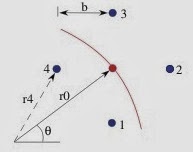

| Visitors Now: | |
| Total Visits: | |
| Total Stories: |

| Story Views | |
| Now: | |
| Last Hour: | |
| Last 24 Hours: | |
| Total: | |
A Simplified Approach for Simultaneous Measurements of Wavefront Velocity and Curvature in the Heart Using Activation Times
I am one of the coauthors on a paper published recently that analyzes how to determine properties of a cardiac wave front from measurements of wave front arrival times (Mazeh, Haines, Kay, and Roth, A Simplified Approach for Simultaneous Measurement of Wavefront Velocity and Curvature in the Heart Using Activation Times, Cardiovascular Engineering and Technology, Volume 4, Pages 520-534, 2013). The lead author, Nachaat Mazeh, is a former grad student of mine who obtained his PhD from Oakland University, and now works in the Beaumont Health System. David Haines is the Director of the Heart Rhythm Center at Beaumont, and is well known for his work on radiofrequency ablation of cardiac tissue. Matthew Kay is a professor of engineering at The George Washington University. In this paper, we obtain the wave front properties from measurement of four arrival times. The result is just simple enough to make into a new homework problem, typical in difficulty to those in the 4th edition of Intermediate Physics for Medicine and Biology.
Section 10.11Problem 43 Suppose you measure the arrival time of an action potential wave front at four points (1-4) in a diamond pattern, each a distance b from the central point (red). Calculate the wave front speed, direction, and curvature from these four measurements.
a) Assume the wave front is circular and propagates outward from the origin. Use the law of cosines to write r1, r2, r3, and r4 (the distance of each electrode to the origin) in terms of r0, b, and the angle θ.
b) Pull a factor of r0 outside of the square root in each of your four expressions from part a).
c) Assume r0 is much greater than b, and perform a Taylor expansion of each of the four expressions in terms of the small parameter ε = b/r0. Include terms that are constant, linear, and quadratic in ε.
d) Write the arrival time at each electrode (n=1, 2, 3, and 4) as tn=rn/v, where v is the wave speed.
e) Let Δtij=ti – tj. Find expressions for Δt13 and Δt24 in terms of b, θ, and v. Solve these expressions to determine v and θ in terms of Δt13, Δt24, and b.
f) Find expressions for Δt14 and Δt23 in terms of b, θ, and v. Now (and this is the most difficult step), find an expression for the radius of curvature, r0, in terms of b, Δt13, Δt24, Δt14, and Δt23.
There are several advantages and several disadvantages to the expressions you will derive. The advantages are that the calculations require only four measurements of arrival time, and they provide not only the speed and direction but also (somewhat unexpectedly–at least to me) the radius of curvature, r0. The radius of curvature is important for propagation, because highly curved wave fronts propagate more slowly than nearly flat wave fronts. The radius of curvature at the core of a spiral wave is highly curved, and this curvature influences properties of the spiral wave such as how fast it rotates. There are some important limitations. First, a close examination of your expression for the radius of curvature will reveal that the method gives an indeterminate expression for propagation at angles of θ = 45, 135, 225, and 315°. Second, the expressions contain the differences of activation times. In fact, the radius of curvature depends on the difference of a difference of activation times. If these activation times are all similar, then they need to be known precisely for the calculation of their differences to be accurate. The calculation assumes the wave front is circular, although really the wave front only needs to be circular locally, so this should not be too bad an approximation. The method also is based on the assumption that b is much less than r0.
Despite these limitations, I think the expressions should be useful for characterizing properties of wave fronts in the heart. It may be particularly useful for obtaining wave front speed, direction, and curvature in computer simulations, where the calculation is computed over a regular two-dimensional Cartesian grid and where noise in the activation times may not be a big concern.
Source: http://hobbieroth.blogspot.com/2013/12/a-simplified-approach-for-simultaneous.html



